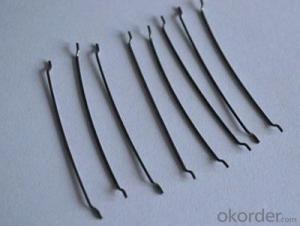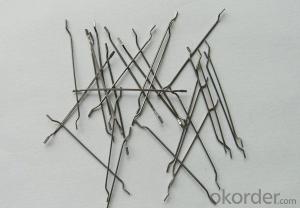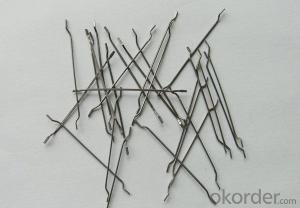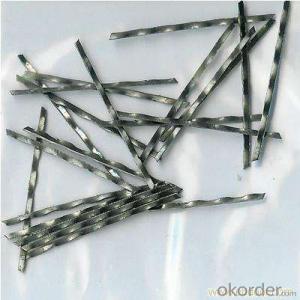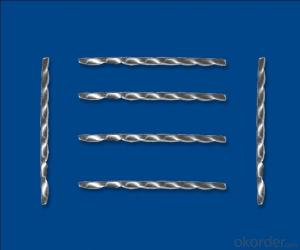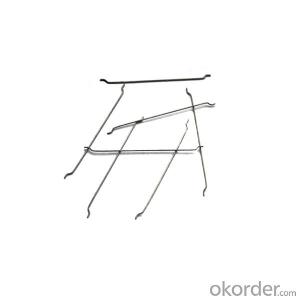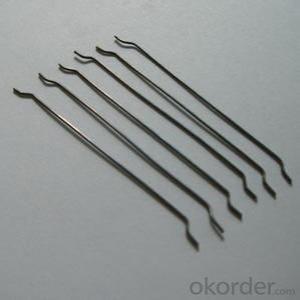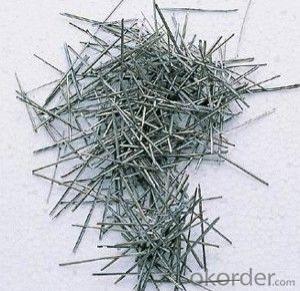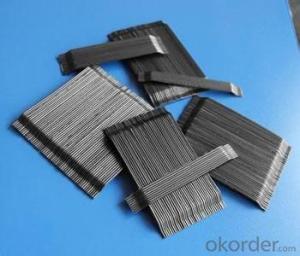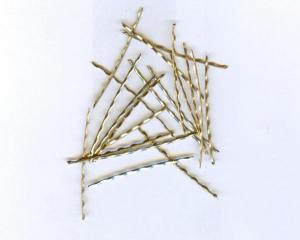Steel Fiber Reinforced Bending And Short
- Loading Port:
- Tianjin
- Payment Terms:
- TT OR LC
- Min Order Qty:
- 5000 kg
- Supply Capability:
- 250000 kg/month
OKorder Service Pledge
OKorder Financial Service
You Might Also Like
Quick Details
Dimensions: steel wire
Grade: steel wire
Application: for concrete reinorcement
Shape: clear and bright
material: steel wire
type: wavy steel fiber
shape: corrugated flat fiber
usage: concrete reinforcement
appearance: clear and bright
Place of Origin: Shandong, China (Mainland)
Product features
steel fiber are for concrete construction, greatly improves concrete bonding and tensile strength .
concrete steel fiber is specially designed to enhance concrete in it`s hardened state ,the uniform distribution of steel fibers throughout the concrete greatly improves concrete bonding and tensile strength ,additionally it provides exceptional load stability and durability .
as reliable and efficient concrete reinforcement material ,it is widely uesd in buildings ,bridges ,thin roof engineering ,highway etc.
Specifications
Diameter :0.5-1.2mm
Tensile strength :≥1100Mpa
Length :20-60mm
properties :excellent tensile ,high tenacity ,against cracking and fatigue
type :any type we can produce according to your request
Picture
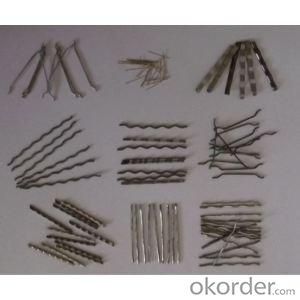
steel fiber concrete reinforced
FAQ
we can produce any type steel fiber and of course we can make production according to your requirement
we have specilize in this field for almost 10 years ,with good quality and competitive price
- Q:Can melt extract stainless steel fiber be used in bridge deck rehabilitation applications?
- Yes, melt extract stainless steel fiber can be used in bridge deck rehabilitation applications.
- Q:How does melt extract stainless steel fiber enhance the resistance of concrete to dynamic loading?
- Melt extract stainless steel fiber enhances the resistance of concrete to dynamic loading by improving its tensile strength and ductility. The fibers act as reinforcements within the concrete matrix, distributing the load more evenly and reducing the formation and propagation of cracks. This results in a more durable and resilient concrete structure that can withstand the impact and vibrations caused by dynamic loading, such as heavy traffic, seismic activity, or machinery operations.
- Q:Can melt extract stainless steel fiber be used in asphalt or bitumen?
- Certainly, melt extract stainless steel fiber finds its application in asphalt or bitumen. It is a prevalent choice as a reinforcement material in the manufacturing process of asphalt or bitumen, as it amplifies its strength, durability, and resistance to cracking. During the production stage, the fibers are incorporated into the mix, ensuring an equal dispersion for reinforcement across the entirety of the asphalt or bitumen mixture. By incorporating stainless steel fibers, the overall performance and lifespan of the asphalt or bitumen are significantly improved, rendering it more resilient against fatigue and cracking induced by intense traffic or external elements.
- Q:Is melt extract stainless steel fiber suitable for use in dam construction?
- Yes, melt extract stainless steel fiber is suitable for use in dam construction. It provides enhanced strength, durability, and resistance to corrosion, making it an ideal reinforcement material for concrete used in dam structures. The fibers help in improving the overall structural integrity and longevity of the dam, making it a reliable choice for this application.
- Q:Can melt extract stainless steel fiber improve the resistance of concrete to chemical attack?
- Yes, melt extract stainless steel fiber can improve the resistance of concrete to chemical attack. The stainless steel fibers act as a reinforcement, enhancing the durability and strength of the concrete. They provide a protective barrier against chemical substances that can degrade the concrete, thereby increasing its resistance to chemical attack.
- Q:Can melt extract stainless steel fiber be used in tunneling and mining applications?
- Certainly! Melt extract stainless steel fiber is applicable in tunneling and mining operations. This particular fiber is renowned for its exceptional strength, durability, and ability to resist corrosion. As a result, it is well-suited for challenging environments like tunnels and mines. It can reinforce various construction materials, including concrete structures and shotcrete, which improves their strength and prevents cracking and deterioration. By incorporating stainless steel fiber, the overall stability and safety of the tunnel or mine can be enhanced by reducing the risk of structural failure or collapse. Moreover, this fiber can endure high temperatures, fire, and abrasive substances, making it a reliable choice for these applications. Ultimately, melt extract stainless steel fiber is an invaluable material that significantly improves the performance and lifespan of tunneling and mining projects.
- Q:How is melt extract stainless steel fiber manufactured?
- Melt extract stainless steel fibers are created using a specialized method that involves melting stainless steel alloys and extracting the molten metal into tiny fibers. To begin the manufacturing process, high-quality stainless steel alloys, which consist of iron, chromium, nickel, and other elements, are chosen. Initially, the selected stainless steel alloys are heated to extremely high temperatures until they reach their melting point. This is typically done in either a furnace or an electric arc melting system. Once the alloys have completely melted, they are prepared for the extraction process. Next, the molten stainless steel is forced through a series of fine spinnerets or nozzles at high speeds. These spinnerets have small openings that allow the molten metal to pass through and form continuous fibers. The diameter of the resulting stainless steel fibers is determined by the size of the spinneret openings. As the molten stainless steel exits the spinnerets, it rapidly cools down and solidifies into solid fibers. These fibers are then collected and undergo further processing to eliminate any impurities or contaminants. This purification can be achieved through mechanical means like air jets or chemical methods such as acid washing or pickling. Once the fibers are clean and pure, they are usually cut into shorter lengths based on the desired application. The final product can vary in length depending on the specific needs of the end user, ranging from a few millimeters to several centimeters. In conclusion, the manufacturing process of melt extract stainless steel fibers involves melting stainless steel alloys, extracting them through spinnerets, cooling and solidifying the fibers, purifying them, and cutting them into desired lengths. This manufacturing process guarantees the production of top-quality stainless steel fibers that can be utilized in various applications, including concrete reinforcement, thermal insulation, and electromagnetic shielding.
- Q:Does melt extract stainless steel fiber improve the resistance to sulfate attack in concrete?
- Yes, melt extract stainless steel fiber does improve the resistance to sulfate attack in concrete. Sulfate attack occurs when sulfates from external sources, such as groundwater or soil, react with the compounds in concrete, leading to its deterioration. The addition of melt extract stainless steel fiber helps to enhance the durability and longevity of concrete structures by providing increased resistance to sulfate attack. Stainless steel fibers are known for their high corrosion resistance, which makes them an ideal reinforcement material in aggressive environments like those prone to sulfate attack. These fibers act as a barrier, inhibiting the penetration of sulfates into the concrete matrix and reducing the potential for chemical reactions that cause degradation. Furthermore, the unique properties of melt extract stainless steel fibers, such as their high tensile strength and flexibility, contribute to improved crack control and overall structural integrity. By effectively distributing stresses and preventing crack propagation, these fibers minimize the ingress of harmful substances, including sulfates, and enhance the concrete's resistance to sulfate attack. Numerous studies and real-world applications have demonstrated the positive impact of melt extract stainless steel fibers on the resistance to sulfate attack in concrete. They have shown reduced cracking, improved resistance to permeability, and enhanced durability in sulfate-rich environments. In conclusion, incorporating melt extract stainless steel fiber in concrete significantly enhances its resistance to sulfate attack. This reinforcement material provides a protective barrier, improves crack control, and increases the overall durability of concrete structures, making them more resilient in aggressive sulfate-rich environments.
- Q:How does melt extract stainless steel fiber improve the bond strength of concrete?
- Concrete bond strength can be significantly enhanced by melt extract stainless steel fiber. The distinct properties of this fiber contribute to its effectiveness in reinforcing the bond between the concrete matrix and the reinforcement. To begin, the melt extract stainless steel fiber possesses a long and slender shape, giving it a high aspect ratio. This unique feature allows the fiber to deeply penetrate the concrete matrix, resulting in a larger surface area for bond formation. Consequently, the interlocking network formed by the fiber within the concrete strengthens the bond. Furthermore, the stainless steel fiber is produced using a melt extraction process, ensuring a uniform and clean composition. This consistency and absence of impurities contribute to a stronger bond with the concrete matrix. The smooth surface of the fiber also prevents any weak points or irregularities that could compromise the bond strength. Additionally, the stainless steel material itself exhibits exceptional tensile strength and corrosion resistance. These properties enable the fiber to withstand external forces and environmental conditions that may deteriorate the bond strength of conventional reinforcement, such as corrosion or chemical attack. Consequently, the incorporation of melt extract stainless steel fiber significantly enhances the durability and long-term performance of the structure. In conclusion, melt extract stainless steel fiber enhances concrete bond strength by offering a high aspect ratio for improved penetration, a uniform composition for consistent bonding, and robust material properties to withstand external forces. The reinforcement provided by this fiber enhances the overall strength and durability of the concrete structure, making it an excellent choice for various construction applications.
- Q:What are the advantages of using melt extract stainless steel fiber?
- There are numerous benefits to utilizing melt extract stainless steel fiber in a variety of applications. To begin with, melt extract stainless steel fiber boasts exceptional strength and durability. Crafted from stainless steel, renowned for its high tensile strength and resistance to corrosion, the fibers are well-suited for use in demanding environments where alternative materials may falter. Furthermore, the utilization of melt extract stainless steel fiber can notably enhance the mechanical properties of a material. When introduced to concrete or other composites, the fibers serve as reinforcement, enhancing toughness, ductility, and crack resistance. As a result, structures become more resilient and long-lasting. In addition, melt extract stainless steel fiber exhibits excellent thermal properties. With a high melting point, it can withstand extreme temperatures without deformation or compromising its structural integrity. Consequently, it is an ideal choice for applications involving high heat or fire hazards. Moreover, melt extract stainless steel fiber offers electromagnetic shielding capabilities. Its conductive nature effectively blocks electromagnetic waves, preventing interference and safeguarding sensitive electronic equipment. This renders it suitable for industries such as aerospace, telecommunications, and electronics. Furthermore, the utilization of melt extract stainless steel fiber can also yield long-term cost savings. By reinforcing materials and structures, it prolongs their lifespan and diminishes the necessity for frequent repairs or replacements. Over time, this can result in substantial cost savings. In conclusion, the advantages of melt extract stainless steel fiber encompass exceptional strength and durability, enhanced mechanical properties, impressive thermal properties, electromagnetic shielding capabilities, and potential cost savings. These qualities establish it as a versatile and dependable choice for various applications across diverse industries.
1. Manufacturer Overview |
|
|---|---|
| Location | |
| Year Established | |
| Annual Output Value | |
| Main Markets | |
| Company Certifications | |
2. Manufacturer Certificates |
|
|---|---|
| a) Certification Name | |
| Range | |
| Reference | |
| Validity Period | |
3. Manufacturer Capability |
|
|---|---|
| a)Trade Capacity | |
| Nearest Port | |
| Export Percentage | |
| No.of Employees in Trade Department | |
| Language Spoken: | |
| b)Factory Information | |
| Factory Size: | |
| No. of Production Lines | |
| Contract Manufacturing | |
| Product Price Range | |
Send your message to us
Steel Fiber Reinforced Bending And Short
- Loading Port:
- Tianjin
- Payment Terms:
- TT OR LC
- Min Order Qty:
- 5000 kg
- Supply Capability:
- 250000 kg/month
OKorder Service Pledge
OKorder Financial Service
Similar products
New products
Hot products
Hot Searches
Related keywords





